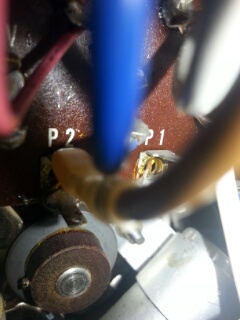This is topic ST-800 voltage? in forum 8mm Forum at 8mm Forum.
To visit this topic, use this URL:
https://8mmforum.film-tech.com/cgi-bin/ubb/ultimatebb.cgi?ubb=get_topic;f=1;t=008772
Posted by Patrick McGrath (Member # 1210) on November 28, 2013, 11:57 PM:
I have this ST-800 I bought inJapan and was wondering if anyone had an idea about the voltage? Specifically, if you look at the photo, you will see a brown wire which comes from the mains, is plugged into P2. Next to that is an empty tab labelled P1. I am wondering if someone who has a US bought unit has the same markings and where is the brown wire connected? My guess is that P1 is 115v and P2 is 100v for Japan but I don't want to just switch it without some sort of confirmation.
Thanks to Winbert for bringing up this possibility. 
Posted by Maurice Leakey (Member # 916) on November 29, 2013, 02:46 PM:
Have you got a Variac and a AC volt-meter?
If so, you could feed a small voltage in and see what you get out.
Posted by Steve Klare (Member # 12) on November 29, 2013, 02:50 PM:
When I am past the Thanksgiving weekend I can check my machine out and let you know what I see.
-dumping it on the dining room table and taking the back cover off is frowned upon with company in the house...for some reason!
If you are running the machine of 100VAC now, and put a voltmeter between P1 and AC neutral, you will see 115VAC there if that is the voltage that terminal is set up for.
(Mind your connections, and your fingers!}
Posted by Patrick McGrath (Member # 1210) on November 29, 2013, 05:04 PM:
I'm pretty good with most electronics but I guess I just don't fully understand transformers.
So, if I am running the machine at 100v albeit through my voltage converter, I can see voltage in that other tab? Perhaps 115?
Just in terms of what I think I know, I think of those tabs as input and measurable voltage would be at the other end...but like I said, I don't fully understand. I'll try that experiment later today.
Thanks!
Posted by Steve Klare (Member # 12) on November 29, 2013, 06:56 PM:
Basically a transformer is a bunch of coils of wire on a core sharing the same magnetic field: the different voltages are because of different numbers of turns for each voltage. The number of volts per turn is the same for all of them.
What this means is if (for example) you have a hundred turns on the 100V winding, you will have 15 more turns in series for the 115V winding. This way whatever the number of turns is on the output winding the voltage will be correct because that volt per turn ratio is the same in both cases.
It also means that because you have that 100 volts already, the extra 15 will show up too whether you are using them or not.
Posted by John Capazzo (Member # 157) on November 29, 2013, 09:04 PM:
Steve is correct; and if you've purchased it from someone in Japan, more than likely a 220v machine. Some had a glass round window to indicate it was 220v. Also, check the inlet for the power cord. They used two round pins as opposed to USA and Canadian models which had three round pins.
Posted by Patrick McGrath (Member # 1210) on November 29, 2013, 09:41 PM:
Well, I tested the other tab but only got a reading of 93 volts. Not sure what that means except that I guess I'll continue to use my converter.
I go to Japan every year and I picked it up while I was there. It does have the two pin plug but definitely is 100 volts. Not only does it say so on the machine but I believe all consumer electronics run 100v. I would imagine there are 220v industrial applications just like here, but the average plug in the wall is always 100v as far as I've seen.
Posted by Dominique De Bast (Member # 3798) on November 29, 2013, 10:12 PM:
I think that they use(d ?) 100 volts in Japan as I have a Japanese Elmo at this voltage.
Posted by Steve Klare (Member # 12) on November 30, 2013, 12:26 AM:
Your 93V means that terminal isn't what we hoped it is. What it really is is another story.
So your ST-800 is running with a two prong inlet? This is actually semi-scary because this means your chassis is ungrounded. If a live conductor detaches inside and touches the frame, the whole thing becomes live and a shock hazard.
The immediate action is to avoid using this projector while in the bathtub!
US spec ST-800s have three prongs in the inlet and their frame grounded.
(Actually a great many projectors are two prong, it's just not the optimum choice!)
Posted by Patrick McGrath (Member # 1210) on November 30, 2013, 12:41 AM:
I wonder what that other story could be?
Not a big deal, but I was hoping to eliminate the converter.
And I'm not overly concerned with the ungrounded chassis. Unless I get invaded by little wire detaching gremlins, I don't think it will be an issue. (I hope!) In the meantime I will certainly not screen films while in the tub.
Thanks for all the help and good advice.
Posted by Maurice Leakey (Member # 916) on November 30, 2013, 03:53 AM:
Don't forget about the differing mains frequencies in Japan. The following guide will help about the voltage and frequencies in Japan.
http://www.japan-guide.com/e/e2225.html
Posted by Martin Jones (Member # 1163) on November 30, 2013, 05:16 AM:
Frequency shouldn't be a problem as this machine, like the ST600, has a DC motor electronically controlled for speed.
Martin
Visit www.film-tech.com for free equipment manual downloads. Copyright 2003-2019 Film-Tech Cinema Systems LLC

UBB.classicTM
6.3.1.2
